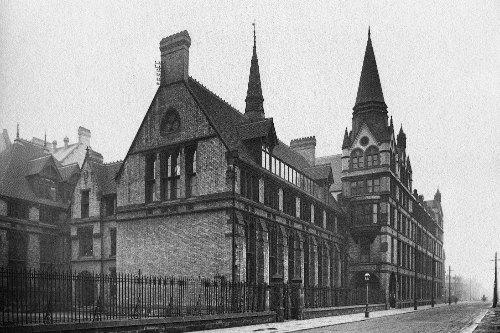The old Medical School
The Medical School was opened in 1874 after Owens College incorporated a private medical school run by doctors.
Formal medical education in Manchester began in 1814 when Joseph Jordan opened the first anatomy school in the English provinces. Previous lecture courses in medicine had included a series given by Peter Mark Roget, then a physician at Manchester Infirmary (1804–8), but better known for his later Thesaurus. Jordan, however, offered dissections as well as lectures, and medical education proved good business. In London the private anatomy schools, which had competed with each other for decades, became incorporated with the hospitals, but in the provinces private medical schools continued beyond 1870, using the hospitals for clinical teaching but not formally attached to them.

Jordan's school was challenged in 1824 by the Pine Street School headed by Thomas Turner, another enterprising surgeon and a third school opened in 1829. All were near the infirmary in Piccadilly, and all catered to students seeking the diplomas needed by new medical practitioners after the Apothecaries Act of 1815. By the 1840s Turner's school was unchallenged, and Turner had been one of the proponents of a university in Manchester. But a new private school started by the surgeon George Southam soon outclassed Turner's school, and took it over when Turner retired in 1856. Southam and Turner had jointly tried to persuade Owens College, which had opened in 1851, to include medicine, but the trustees had refused because they feared medical students would lower the tone of the new college.
Over the next decade the relationships changed as the medical profession and the government raised the standards of medical education, including more laboratory science – and there was pressure for better behaviour. In the later 1860s Owens College looked to increase its provision for laboratory sciences, and saw medical students as a profitable audience. As it planned its extension and move, Owens agreed to take over Southam's school. That the medical school would now be based down Oxford Road then added to the arguments for moving the infirmary away from the city centre, which eventually happened in 1908.
In 1874 Thomas Henry Huxley officially opened the new medical school building, in the back quadrangle, behind the main college buildings. It had a library, a museum, a dissection room and an excellent physiology laboratory, headed by Professor Arthur Gamgee, a chemical physiologist who was expected to link the medical school with the strength of Henry Roscoe's chemistry department. Several of the clinical staff who came from Southam's school were nationally known; for example, William Roberts was one of the north's most eminent physicians and a noted experimentalist – in the laboratory at his home.
The medical building was extended in the 1880s, and connected with the extensions of the chemistry department. A large extension was built on Coupland Street in the mid-1890s, which made Manchester one of the largest and best-equipped medical schools in England. Its staff before World War I included Sheridan Delépine, a Swiss-born pathologist who developed public health bacteriology, and Grafton Elliot Smith, an Australian anatomist who modernised his subject to include X-rays, functional anatomy and anthropology. Having previously taught anatomy in Cairo, Smith was also an Egyptologist, and while in Manchester he wrote several books developing his 'diffusionist' reading of human history: almost everything had originated from one culture, usually in ancient Egypt, and had then spread.
Among Smith's pupils were three Manchester graduates who helped lead Manchester medicine past World War II: Sir Geoffrey Jefferson, one of the British founders of neurosurgery; Harry Platt, the noted orthopaedic surgeon; and Lord John Sebastian Bach Stopford who after World War I followed Elliot Smith as Professor of Anatomy, before becoming, successively, Dean of Medicine, Vice-Chancellor of the University and then, under the new NHS, the first Chairman of the Manchester Regional Hospital Board.
In 1974 the medical school moved to a new building, named for Stopford.
